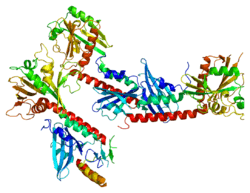RAP1GAP
Rap1 GTPase-activating protein 1 is an enzyme that in humans is encoded by the RAP1GAP gene.[5][6]
Interactions
RAP1GAP has been shown to interact with MLLT4.[7]
References
- 1 2 3 GRCh38: Ensembl release 89: ENSG00000076864 - Ensembl, May 2017
- 1 2 3 GRCm38: Ensembl release 89: ENSMUSG00000041351 - Ensembl, May 2017
- ↑ "Human PubMed Reference:".
- ↑ "Mouse PubMed Reference:".
- ↑ Rubinfeld B, Munemitsu S, Clark R, Conroy L, Watt K, Crosier WJ, McCormick F, Polakis P (Jul 1991). "Molecular cloning of a GTPase activating protein specific for the Krev-1 protein p21rap1". Cell. 65 (6): 1033–42. PMID 1904317. doi:10.1016/0092-8674(91)90555-D.
- ↑ "Entrez Gene: RAP1GAP RAP1 GTPase activating protein".
- ↑ Su, Li; Hattori Masakazu; Moriyama Masaki; Murata Norihito; Harazaki Masashi; Kaibuchi Kozo; Minato Nagahiro (Apr 2003). "AF-6 controls integrin-mediated cell adhesion by regulating Rap1 activation through the specific recruitment of Rap1GTP and SPA-1". J. Biol. Chem. United States. 278 (17): 15232–8. ISSN 0021-9258. PMID 12590145. doi:10.1074/jbc.M211888200.
Further reading
- Hattori M, Minato N (2004). "Rap1 GTPase: functions, regulation, and malignancy.". J. Biochem. 134 (4): 479–84. PMID 14607972. doi:10.1093/jb/mvg180.
- Rubinfeld B, Crosier WJ, Albert I, et al. (1992). "Localization of the rap1GAP catalytic domain and sites of phosphorylation by mutational analysis". Mol. Cell. Biol. 12 (10): 4634–42. PMC 360390
 . PMID 1406653.
. PMID 1406653. - Weiss J, Rubinfeld B, Polakis PG, et al. (1994). "The RAP1GA1 locus for human Rap1-GTPase activating protein 1 maps to chromosome 1p36.1→p35". Cytogenet. Cell Genet. 66 (1): 18–21. PMID 8275700. doi:10.1159/000133655.
- Peterson SN, Trabalzini L, Brtva TR, et al. (1997). "Identification of a novel RalGDS-related protein as a candidate effector for Ras and Rap1". J. Biol. Chem. 271 (47): 29903–8. PMID 8939933. doi:10.1074/jbc.271.47.29903.
- Kurachi H, Wada Y, Tsukamoto N, et al. (1997). "Human SPA-1 gene product selectively expressed in lymphoid tissues is a specific GTPase-activating protein for Rap1 and Rap2. Segregate expression profiles from a rap1GAP gene product". J. Biol. Chem. 272 (44): 28081–8. PMID 9346962. doi:10.1074/jbc.272.44.28081.
- Seki N, Ohira M, Nagase T, et al. (1998). "Characterization of cDNA clones in size-fractionated cDNA libraries from human brain". DNA Res. 4 (5): 345–9. PMID 9455484. doi:10.1093/dnares/4.5.345.
- Mochizuki N, Ohba Y, Kiyokawa E, et al. (1999). "Activation of the ERK/MAPK pathway by an isoform of rap1GAP associated with G alpha(i)". Nature. 400 (6747): 891–4. PMID 10476970. doi:10.1038/23738.
- Meng J, Glick JL, Polakis P, Casey PJ (2000). "Functional interaction between Galpha(z) and Rap1GAP suggests a novel form of cellular cross-talk". J. Biol. Chem. 274 (51): 36663–9. PMID 10593970. doi:10.1074/jbc.274.51.36663.
- Berruti G (2000). "A novel rap1/B-Raf/14-3-3 theta protein complex is formed in vivo during the morphogenetic differentiation of postmeiotic male germ cells". Exp. Cell Res. 257 (1): 172–9. PMID 10854065. doi:10.1006/excr.2000.4877.
- Kao S, Jaiswal RK, Kolch W, Landreth GE (2001). "Identification of the mechanisms regulating the differential activation of the mapk cascade by epidermal growth factor and nerve growth factor in PC12 cells". J. Biol. Chem. 276 (21): 18169–77. PMID 11278445. doi:10.1074/jbc.M008870200.
- Klinger M, Kudlacek O, Seidel MG, et al. (2002). "MAP kinase stimulation by cAMP does not require RAP1 but SRC family kinases". J. Biol. Chem. 277 (36): 32490–7. PMID 12082090. doi:10.1074/jbc.M200556200.
- Liu L, Schwartz BR, Tupper J, et al. (2002). "The GTPase Rap1 regulates phorbol 12-myristate 13-acetate-stimulated but not ligand-induced beta 1 integrin-dependent leukocyte adhesion". J. Biol. Chem. 277 (43): 40893–900. PMID 12091396. doi:10.1074/jbc.M206208200.
- de Bruyn KM, Rangarajan S, Reedquist KA, et al. (2002). "The small GTPase Rap1 is required for Mn(2+)- and antibody-induced LFA-1- and VLA-4-mediated cell adhesion". J. Biol. Chem. 277 (33): 29468–76. PMID 12171996. doi:10.1074/jbc.M204990200.
- Meng J, Casey PJ (2003). "Activation of Gz attenuates Rap1-mediated differentiation of PC12 cells". J. Biol. Chem. 277 (45): 43417–24. PMID 12198116. doi:10.1074/jbc.M204074200.
- Schmitt JM, Stork PJ (2003). "Galpha and Gbeta gamma require distinct Src-dependent pathways to activate Rap1 and Ras". J. Biol. Chem. 277 (45): 43024–32. PMID 12221082. doi:10.1074/jbc.M204006200.
- Delehanty LL, Mogass M, Gonias SL, et al. (2003). "Stromal inhibition of megakaryocytic differentiation is associated with blockade of sustained Rap1 activation". Blood. 101 (5): 1744–51. PMID 12393469. doi:10.1182/blood-2002-04-1278.
- Grader-Beck T, van Puijenbroek AA, Nadler LM, Boussiotis VA (2003). "cAMP inhibits both Ras and Rap1 activation in primary human T lymphocytes, but only Ras inhibition correlates with blockade of cell cycle progression". Blood. 101 (3): 998–1006. PMID 12393539. doi:10.1182/blood-2002-06-1665.
- Gendron L, Oligny JF, Payet MD, Gallo-Payet N (2003). "Cyclic AMP-independent involvement of Rap1/B-Raf in the angiotensin II AT2 receptor signaling pathway in NG108-15 cells". J. Biol. Chem. 278 (6): 3606–14. PMID 12464615. doi:10.1074/jbc.M202446200.
- Strausberg RL, Feingold EA, Grouse LH, et al. (2003). "Generation and initial analysis of more than 15,000 full-length human and mouse cDNA sequences". Proc. Natl. Acad. Sci. U.S.A. 99 (26): 16899–903. PMC 139241
 . PMID 12477932. doi:10.1073/pnas.242603899.
. PMID 12477932. doi:10.1073/pnas.242603899.
This article is issued from
Wikipedia.
The text is licensed under Creative Commons - Attribution - Sharealike.
Additional terms may apply for the media files.






